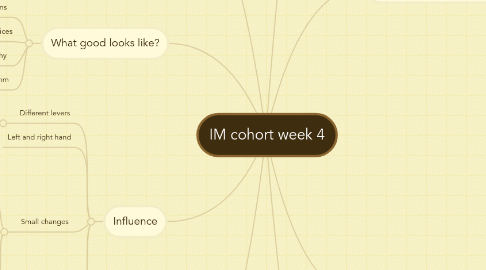
1. Self-organising squads
1.1. Advantages
1.1.1. Autonomy
1.1.2. Ownership
1.2. Disadvantages
1.2.1. No one takes responsibility
1.3. Defined
1.3.1. distributed control, i.e. absence of centralised control
1.3.2. continuous adaptation to a changing environment
1.3.3. emergent structure from local interaction
1.3.4. feedback, both positive and negative
1.3.5. resilience due to the system’s ability to repair and adjust
1.4. resources
1.4.1. http://confluence.int.corp.sun/confluence/display/ALP/Self-Organising+Teams
2. Ideal team player desirable attributes
2.1. Humble
2.1.1. Defined
2.1.1.1. I compliment or praise them without hesitation.
2.1.1.2. I easily admit to my mistakes.
2.1.1.3. I am willing to take on lower-level work for the good of the team.
2.1.1.4. I gladly share credit for team accomplishments.
2.1.1.5. I readily acknowledge my weaknesses.
2.1.1.6. I offer and accept apologies graciously.
2.2. Hungry
2.2.1. Defined
2.2.1.1. I do more than what is required in my own job.
2.2.1.2. I have passion for the “mission” of the team.
2.2.1.3. I feel a sense of personal responsibility for the overall success of the team.
2.2.1.4. I am willing to contribute to and think about work outside of office hours.
2.2.1.5. I am willing to take on tedious or challenging tasks whenever necessary.
2.2.1.6. I look for opportunities to contribute outside of my area of responsibility.
2.3. People smarts
2.3.1. Defined
2.3.1.1. I generally understand what others are feeling during meetings and conversations.
2.3.1.2. I show empathy to others on the team.
2.3.1.3. I demonstrate an interest in the lives of my teammates.
2.3.1.4. I am an attentive listener.
2.3.1.5. I am aware of how my words and actions impact others on the team.
2.3.1.6. I adjust my behavior and style to fit the nature of a conversation or relationship.
3. High performance squads
3.1. defined
3.1.1. outperform expectations given the sum of the parts (synergy and emergent properties)
3.2. attributes:
3.2.1. Understand difference between urgent and important
3.2.2. everyone really cares
3.2.3. strong commitment from everyone on how the work gets done, swarm problems and continuously improve
3.2.4. mutual accountability and dependability
3.2.5. everyone is aligned to team's purpose, and feel they are working on something that is personally important to them and fundamentally believe that the work we’re doing matters
3.2.6. psychological safety: everyone can take risks and solve problems openly and honestly without feeling insecure or embarrassed
3.2.7. diversity of thought and background and equal contribution
4. What good looks like?
4.1. Four quadrants of Lyssa Adkins
4.2. "Obviously" not just whether you are doing your basic practices
4.2.1. LAMA defines sustainable not high performing
4.3. Peachy
4.3.1. http://confluence.int.corp.sun/confluence/display/ALP/Everything+is+peachy+when
4.4. Agile mm
4.4.1. https://www.mindmeister.com/886510943/agile
5. Influence
5.1. Different levers
5.1.1. Six Matrix
5.1.1.1. http://confluence.int.corp.sun/confluence/display/ALP/Influencing+Tips
5.2. Left and right hand
5.3. Small changes
5.3.1. Motvate
5.3.1.1. Education
5.3.1.2. Dark forest
5.3.2. Familiarity
5.3.2.1. Plenty of warning
5.3.2.2. Make aware
5.3.3. Part of iteration
5.3.4. Habit
5.4. Respect, trust
5.5. Motivate the need
6. Five dysfunctions of a team
6.1. #1: ABSENCE OF TRUST
6.1.1. The fear of being vulnerable with team members prevents the building of trust within the team.
6.2. #2: FEAR OF CONFLICT
6.2.1. The desire to preserve artificial harmony stifles the occurrence of productive, ideological conflict.
6.3. #3: LACK OF COMMITMENT
6.3.1. The lack of clarity and/or the fear of being wrong prevents team members from making decisions in a timely and definitive way.
6.4. #4: AVOIDANCE OF ACCOUNTABILITY
6.4.1. The need to avoid interpersonal discomfort prevents team members from holding one another accountable for their behaviors.
6.5. #5: INATTENTION TO RESULTS
6.5.1. The desire for individual credit erodes the focus on collective success.
6.6. The book
6.6.1. The Five Dysfunctions of a Team: A Leadership Fable
6.6.1.1. by Patrick Lencioni
7. Motivation: what are some prerequisites
7.1. Dan Pink
7.1.1. Autonomy
7.1.2. Purpose
7.1.3. Mastery
7.1.4. video:
7.1.4.1. https://www.youtube.com/watch?v=u6XAPnuFjJc
7.2. Demotivators
7.2.1. ...
7.2.2. IM as protector and supporter
7.3. http://confluence.int.corp.sun/confluence/display/ALP/Theory+X+and+Theory+Y
8. Servant leader
8.1. Inclusive
8.1.1. Actually care
8.1.2. Take time to know each person
8.2. defined
8.2.1. self-reflects
8.2.2. values diverse opinions
8.2.3. cultivates a culture of trust, respect and acts with humility
8.2.4. develops others as servant leaders
8.2.5. puts others first, encourages and helps people beyond just work issues
8.2.6. sells instead of tells
8.2.7. listens intently and observes closely
8.2.8. thinks long-term and demonstrates persistence
8.2.9. holds himself and others accountable for their commitments
8.3. THE book
8.3.1. Servant Leadership: A Journey into the Nature of Legitimate Power and Greatness
8.3.1.1. by Robert K. Greenleaf
